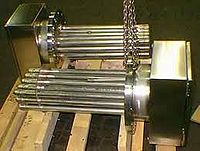Difference between revisions of "Tank Heaters"
(Created page with "Category:Heating{{Knoppen}} <noinclude><!------------------------------------------------ * READ THIS FIRST * Only edit this page if you can improve the content. * Improper ...") |
PurplePen19 (talk | contribs) |
||
| Line 7: | Line 7: | ||
* Please start editing this page after the /noinclude | * Please start editing this page after the /noinclude | ||
* -------------------------------------------------></noinclude> | * -------------------------------------------------></noinclude> | ||
[[File:Tank Heaters.jpg|thumb|200px|right|Tank Heaters]] | |||
'''Tank Heaters''' are uniquely designed to heat large storage tanks located above or below ground and containing highly viscous fluids or heat sensitive materials. The systems can be installed in above or below-ground tanks made of steel, concrete, or fiberglass. Tank heaters are flexible wrap-around surface heaters offered in different sizes based on height. | |||
==Features== | |||
Tank heaters are built to withstand the rigorous demands encountered in industrial installations. The heavy-duty features of the units were developed in response to a need for tank heaters that could provide efficient heat transfer without sacrificing structural integrity. | |||
These features include heavy-walled pipes and headers, thick L-footed fins, and all-welded construction. In addition, the mono-metallic construction of our units precludes galvanic corrosion, and the finned surface is rigid enough to withstand high-pressure cleaning without damage or distortion. | |||
==Benefits== | |||
Tank heaters are easier than bare pipe units to install, remove and repair. They are also more compact and provide superior efficiency in product heating. Finned-pipe tank heaters provide up to 10 times as much heat transfer as an equivalent length of bare pipe, resulting in lower film or “skin” temperatures. | |||
This lower temperature reduces coking of the product on the heat transfer surface and discoloration of heat-sensitive products. Buildup of deposits on the heater requires more frequent cleanings to maintain maximum efficiency and original heat transfer design conditions. | |||
Helically wound finned pipes are best suited for horizontal units, with the fins being in the vertical plane. This increases the natural convection currents, which increases heat transfer and continuously wipes the coil surface to maintain cleanliness. | |||
Latest revision as of 18:15, 28 August 2012
Tank Heaters are uniquely designed to heat large storage tanks located above or below ground and containing highly viscous fluids or heat sensitive materials. The systems can be installed in above or below-ground tanks made of steel, concrete, or fiberglass. Tank heaters are flexible wrap-around surface heaters offered in different sizes based on height.
Features
Tank heaters are built to withstand the rigorous demands encountered in industrial installations. The heavy-duty features of the units were developed in response to a need for tank heaters that could provide efficient heat transfer without sacrificing structural integrity.
These features include heavy-walled pipes and headers, thick L-footed fins, and all-welded construction. In addition, the mono-metallic construction of our units precludes galvanic corrosion, and the finned surface is rigid enough to withstand high-pressure cleaning without damage or distortion.
Benefits
Tank heaters are easier than bare pipe units to install, remove and repair. They are also more compact and provide superior efficiency in product heating. Finned-pipe tank heaters provide up to 10 times as much heat transfer as an equivalent length of bare pipe, resulting in lower film or “skin” temperatures.
This lower temperature reduces coking of the product on the heat transfer surface and discoloration of heat-sensitive products. Buildup of deposits on the heater requires more frequent cleanings to maintain maximum efficiency and original heat transfer design conditions.
Helically wound finned pipes are best suited for horizontal units, with the fins being in the vertical plane. This increases the natural convection currents, which increases heat transfer and continuously wipes the coil surface to maintain cleanliness.
